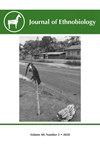Locusts and Grasshoppers Acridoidea Ethnobiology of the South American Gran Chaco: A Review
IF 1.3
3区 社会学
Q1 ANTHROPOLOGY
引用次数: 0
Abstract
Abstract. Migratory locusts are among the most damaging agricultural plagues in the world. However, the role of grasshoppers and locusts in human societies embraces other cultural dimensions. For the Gran Chaco (an immense plain located in the west of Paraguay, the north of Argentina, a small portion of the south-west of Brazil, and part of the east of Bolivia), the documentation available contains no clear description of the topic, although information is scattered throughout a variety of bibliographic sources. This study presents a synthesis of the significance and role of locusts and grasshoppers for Indigenous communities of the Gran Chaco. It is the result of an exhaustive bibliographic review of the region, as well as fieldwork conducted with various Toba communities. The resulting information has been organized by cultural topic. The references come under ten headings: food, damage, shamanism, fishing, toponyms, names of bands, textile art, string games, oral narrative, and vernacular nomenclature. Details describing forms of gathering and consumption, present and past uses, as well as the reasons why they were abandoned, were recorded, along with negative assessments and the fear experienced at the arrival of swarms of locusts. This synthesis allows reconstruction of a historical cultural aspect of the Gran Chaco which has received little attention, while recording prevailing cultural aspects and others that have fallen into disuse.南美大查科蝗虫蝗总科人种生物学综述
摘要迁徙的蝗虫是世界上最具破坏性的农业灾害之一。然而,蚱蜢和蝗虫在人类社会中的作用还包括其他文化层面。对于Gran Chaco(位于巴拉圭西部,阿根廷北部,巴西西南部的一小部分和玻利维亚东部的部分地区的一个巨大平原),尽管信息分散在各种书目来源中,但现有的文档中没有对该主题的明确描述。本研究综合了蝗虫和蚱蜢对大查科土著社区的意义和作用。这是对该地区详尽的书目审查以及对多巴各社区进行实地调查的结果。所得信息已按文化主题组织。参考文献分为10个标题:食物、损害、萨满教、钓鱼、地名、乐队名称、纺织艺术、绳游戏、口头叙述和方言命名。详细描述了收集和消费的形式,现在和过去的用途,以及它们被遗弃的原因,以及对蝗虫群到来的负面评价和恐惧。这种综合可以重建很少受到关注的大查科的历史文化方面,同时记录流行的文化方面和其他已经废弃的文化方面。
本文章由计算机程序翻译,如有差异,请以英文原文为准。
求助全文
约1分钟内获得全文
求助全文
来源期刊

Journal of Ethnobiology
Social Sciences-Anthropology
CiteScore
4.80
自引率
3.40%
发文量
21
审稿时长
>12 weeks
期刊介绍:
JoE’s readership is as wide and diverse as ethnobiology itself, with readers spanning from both the natural and social sciences. Not surprisingly, a glance at the papers published in the Journal reveals the depth and breadth of topics, extending from studies in archaeology and the origins of agriculture, to folk classification systems, to food composition, plants, birds, mammals, fungi and everything in between.
Research areas published in JoE include but are not limited to neo- and paleo-ethnobiology, zooarchaeology, ethnobotany, ethnozoology, ethnopharmacology, ethnoecology, linguistic ethnobiology, human paleoecology, and many other related fields of study within anthropology and biology, such as taxonomy, conservation biology, ethnography, political ecology, and cognitive and cultural anthropology.
JoE does not limit itself to a single perspective, approach or discipline, but seeks to represent the full spectrum and wide diversity of the field of ethnobiology, including cognitive, symbolic, linguistic, ecological, and economic aspects of human interactions with our living world. Articles that significantly advance ethnobiological theory and/or methodology are particularly welcome, as well as studies bridging across disciplines and knowledge systems. JoE does not publish uncontextualized data such as species lists; appropriate submissions must elaborate on the ethnobiological context of findings.
 求助内容:
求助内容: 应助结果提醒方式:
应助结果提醒方式:


